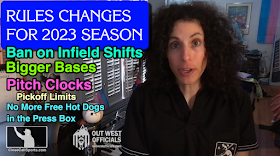In continuation of our educational series, we review baseball's criteria for ejection, also known as the Standards for Removal from the Game. The following list comprises a majority of reasons an umpire may eject a player, coach, or manager from a ballgame ranging from physical abuse, battery, and assault, to personal, profane, and prolonged complaining.
Standard 1) Profanity or Vulgar Insults Directed at/of Umpire: This criterion comprises statements of obscenity and unsporting personal insults of an umpire.
Standard 2) Physical Contact with an Umpire: This includes so-called bumping an umpire and other instances of improperly touching an umpire.
Standard 3) Refusal to Stop Arguing / Delaying the Game: Also known as prolonged or continued complaining, this standard includes an on-field argument that the player/coach/manager continues even after being instructed/warned by an umpire to stop, as well as continued complaining from the field or from the dugout. Continued Complaining ejections also apply to arguing a call from a prior game or prior inning.
Standard 4) Leaving Position to Argue Balls and Strikes (Including Half Swings): Leaving one's position to argue ball/strike calls, which include check swings *and balks* is ground for ejection from the game.
Standard 5) Arguing a Replay Review or Any Changed Call: Arguing a Replay Official's decision to confirm/stand/overturn a call or arguing an on-field umpiring crew's decision to change a call is ground for ejection. This provision also includes citing video evidence to contradict an on-field ruling.
Standard 6) Use of Histrionic Gestures or Gesturing Toward an Umpire: Using exaggerated body movements or gestures to dispute an umpire's action is ground for ejection. Throwing objects from the dugout or bullpen is also included under this provision.
Standard 7) Actions Intended to Ridicule: This includes actions such as a player drawing a line with their bat to indicate where they thought a pitch was located, or a manager mimicking an umpire's calls/signals or covering home plate with dirt.
Standard 8) Throwing Equipment in Disgust: This includes throwing equipment as well as a uniform item in reaction to a call or during the course of an argument. A batter throwing a helmet or manager throwing a hat is covered by this provision.
- - S8: Intermediate Warning) Umpires may issue an equipment violation as an intermediary step in lieu of ejection for throwing equipment in disgust for less severe infractions of this provision. For instance, a batter who throws a bat after striking out may be warned (and fined) via an equipment violation instead of ejected outright, if the umpire judges the infraction of minor severity. However, severe violations as well as any violation of this provision after being warned (via equipment violation) shall result in ejection.
Standard 9) Failure to Comply with an Umpire's Order: If a game participant refuses to comply with an umpire's order to do or refrain from doing something that affects the administration of the Official Baseball Rules (including pace of play initiatives), the offender may be ejected for such failure to comply. This includes ejections for refusing to enter the batter's box (MLB only — some lower levels have intermediary penalties, such as automatic strikes).
Standard 10) Arguing or Disputing a Warning or Ejection (or Lack Thereof): A player, coach, or manager shall be ejected for disputing an umpire or umpiring crew's decision to warn or eject a participant, or decision to refrain from issuing such warning or ejection. An umpire's decision relative to a participant's game status (warning/ejection) is final and may not be argued.
Standard 11) Intentionally Throwing at Batter: A pitcher or pitcher and their manager may be ejected for intentionally throwing at an opposing batter. In lieu of ejection, the umpire may issue warnings to both teams that the next such infraction will result in the ejection of the offending pitcher and their manager.
Standard 12) Unsporting NEC and Fighting: Participating or being charged with fighting shall result in automatic ejection of the offender(s) (lower levels, e.g., NCAA & NFHS, may have more strict rules regarding unsporting situations, than professional baseball). Unsporting actions not elsewhere specified—which includes the provisions referred to in Official Baseball Rule 6.04(a) [Unsportsmanlike Conduct] [incitement, language, calling "Time" to try and induce a balk or movement to distract the batter]—are included here, as well as foreign substance ejections (e.g., pine tar on pitcher or corked bat).
Video as follows:































